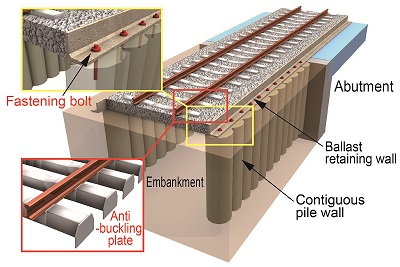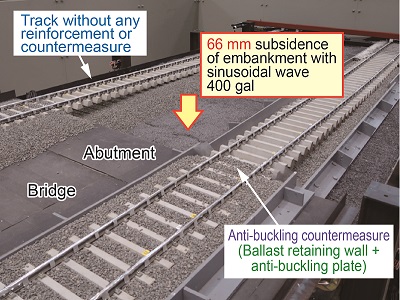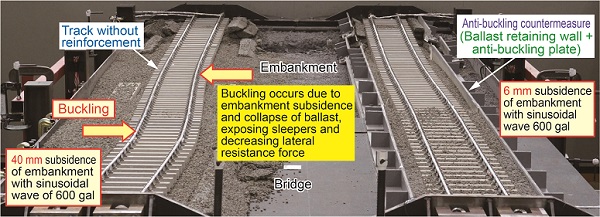3. Countermeasures to prevent subsidence of abutment backfill and track buckling during earthquakes
The mechanisms leading to buckling of ballasted track with continuous welded rail due to the decrease of lateral resistance force by the subsidence of abutment backfill, were clarified. Based on the insight gained, a countermeasure was proposed to prevent the fall in lateral resistance force, consisting of a contiguous pile wall to reinforce the abutment backfill, buckling prevention plates added to sleeper ends, and installation of a ballast retaining wall fixed to the pile wall (Fig.1).
A large scale shaking table test was performed on an integrated embankment / track model (scale of 1/9) with heated rails to raise axial forces to reproduce abutment backfill subsidence and track buckling, and to investigate the effectiveness of the proposed anti-buckling countermeasure.
For tests carried out with the unreinforced abutment backfill, significant subsidence occurred without track buckling when a 400gal sinusoidal wave was input (Fig. 2). In the case where the embankment was reinforced with a contiguous pile wall, subsidence was reduced to about a third of the case where no contiguous pile wall was added. However, when only the abutment backfill was reinforced (without track reinforcement) and the sinusoidal wave was increased to 600gal, to simulate a very large earthquake, exceeding the force of an L2 earthquake, track buckling occurred. When anti-buckling plates were added to each end of each sleeper, and a ballast retaining wall fixed to the contiguous pile wall, no buckling occurred when sinusoidal waves of 600gal and even 700 gal were input, confirming that this countermeasure is effective for the prevention of track buckling (Fig. 3).
Other Contents
- 1. Earthquake damage simulator for railways with self-correcting function
- 2. Practical application of early earthquake warning method using ocean bottom seismometer data
- 3. Countermeasures to prevent subsidence of abutment backfill and track buckling during earthquakes
- 4. Ground surface layer response evaluation method for very large earthquakes
- 5. Anti-seismic reinforcement method for suspended-ceilings with small cavities at stations
- 6. Algorithm to estimate strong wind locations due to such as gusts.
- 7. Flowchart to determine possibility of reusing bridge following scouring damage
- 8. Increase in accuracy of bogie hunting stability evaluation
- 9. Driver visual recognition support method using image processing
- 10. Health monitoring of very large structures using long-range U-Doppler
- 11. Influence of pinion shaft bearing endplay (axial clearance) on its seizure initiation
- 1. Earthquake damage simulator for railways with self-correcting function
- 2. Practical application of early earthquake warning method using ocean bottom seismometer data
- 3. Countermeasures to prevent subsidence of abutment backfill and track buckling during earthquakes
- 4. Ground surface layer response evaluation method for very large earthquakes
- 5. Anti-seismic reinforcement method for suspended-ceilings with small cavities at stations
- 6. Algorithm to estimate strong wind locations due to such as gusts.
- 7. Flowchart to determine possibility of reusing bridge following scouring damage
- 8. Increase in accuracy of bogie hunting stability evaluation
- 9. Driver visual recognition support method using image processing
- 10. Health monitoring of very large structures using long-range U-Doppler
- 11. Influence of pinion shaft bearing endplay (axial clearance) on its seizure initiation



